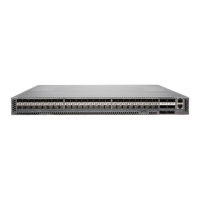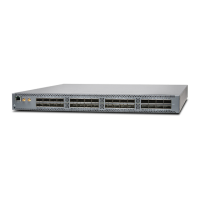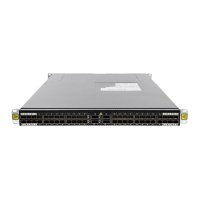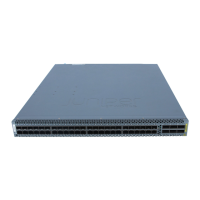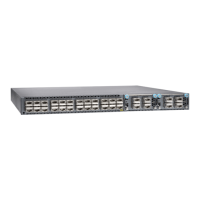The remaining 4 QSFP28 ports (48 through 51) support speeds of 40 Gbps or 100 Gbps.
Each port can be configured as an independent 100-Gigabit Ethernet port or as an
independent 40-Gigabit Ethernet port. These port are usually used as uplinks. In
40-Gigabit Ethernet mode, these ports can be channelized using QSP+ to SFP+ DAC
breakout (DACBO) cables.
You can find information about the optical transceivers supported on your Juniper device
by using the Hardware Compatibility Tool. In addition to transceiver and connection type,
the optical and cable characteristics–where applicable–are documented for each
transceiver. The Hardware Compatibility Tool enables you to search by product, displaying
all the transceivers supported on that device, or category, by interface speed or type. The
list of supported transceivers for the QFX5110 is located at
https://pathfinder.juniper.net/hct/product/#prd=QFX5110.
CAUTION: If you face a problem running a Juniper Networks device that uses
a third-party optic or cable, the Juniper Networks Technical Assistance Center
(JTAC) can help you diagnose the source of the problem. Your JTAC engineer
might recommendthat youcheck the third-partyoptic or cableand potentially
replace it with an equivalent Juniper Networks optic or cable that is qualified
for the device.
Cable Specifications for QSFP+ and QSFP28 Transceivers
The 40-Gigabit Ethernet QSFP+ and 100-Gigabit Ethernet QSFP28 transceivers that are
used in QFX Series switches use 12-ribbon multimode fiber crossover cables with female
MPO/UPC connectors. The fiber can be either OM3 or OM4. These cables are not sold
by Juniper Networks.
CAUTION: To maintain agency approvals, use only a properly constructed,
shielded cable.
TIP: Ensure that you order cables with the correct polarity. Vendors refer to
these crossover cables as key up to key up, latch up to latch up, Type B, or
Method B. If you are using patch panels between two QSFP+ or QSFP28
transceivers, ensure that the proper polarity is maintained through the cable
plant.
Table 27 on page 70 describes the signals on each fiber. Table 28 on page 71 shows the
pin-to-pin connections for proper polarity.
Table 27: QSFP+ and QSFP28 Optical Module Receptacle Pinouts
SignalFiber
Tx0 (Transmit)1
Copyright © 2019, Juniper Networks, Inc.70
QFX5110 Switch Hardware Guide
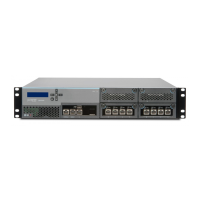
